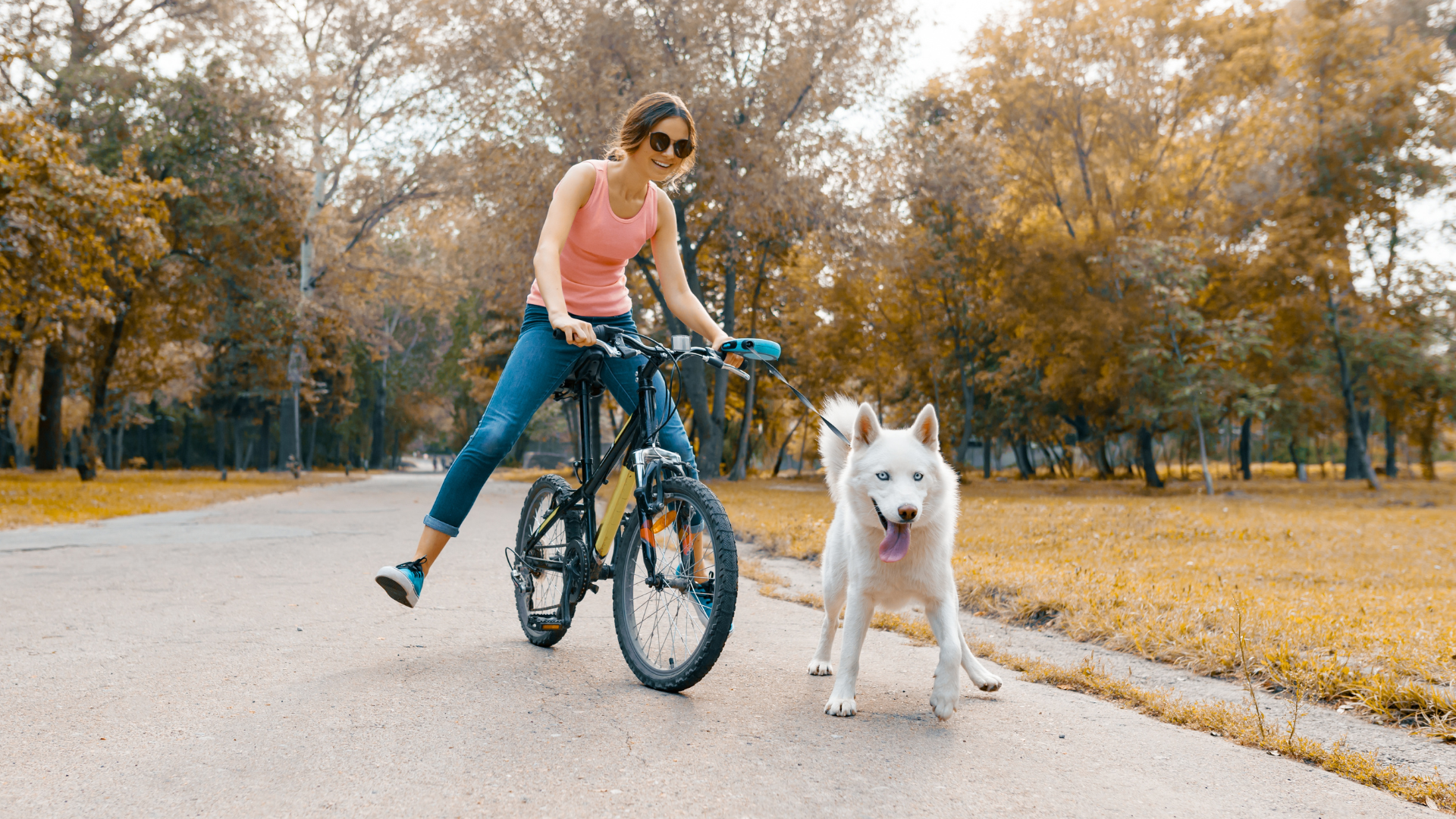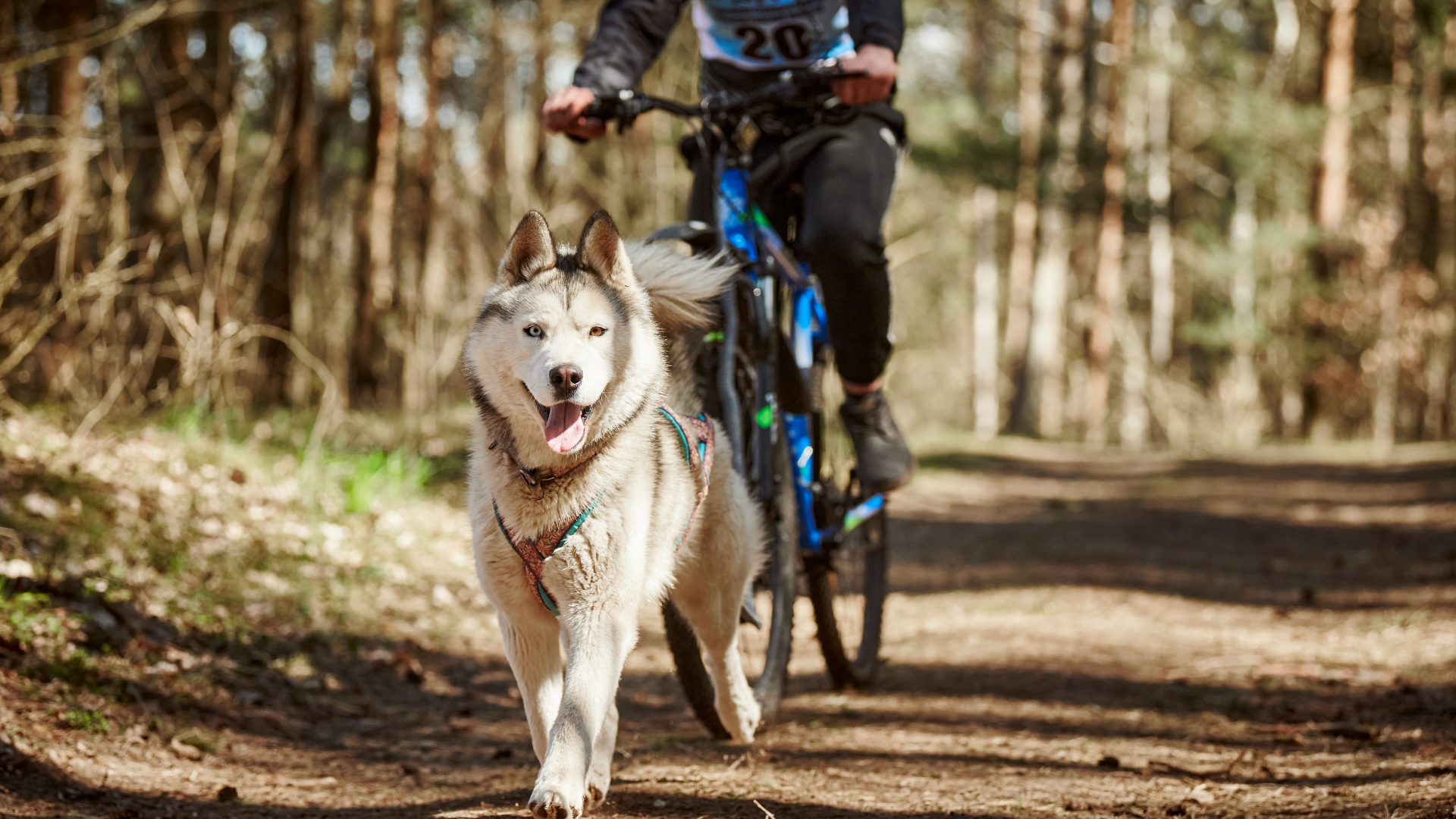Riding a bike with a dog can be a fun and enjoyable activity for both the owner and the pet. It allows the owner to get some exercise while also spending quality time with their furry friend. However, it is important to take certain precautions and follow some guidelines to ensure the safety of both the owner and the dog.

Firstly, it is crucial to make sure that the dog is comfortable with riding in a bike basket or trailer. Introducing the dog to the equipment gradually and patiently can help them feel more at ease. It is also important to ensure that the equipment is sturdy and secure, and that the dog is safely fastened in before setting off on the ride. Additionally, the owner should avoid taking the dog on long or strenuous rides, especially in extreme weather conditions.
Overall, riding a bike with a dog can be a fun and rewarding experience as long as the necessary precautions are taken. By following these guidelines, owners can enjoy spending quality time with their pets while also getting some exercise and fresh air.

Benefits of Riding with Your Dog
Riding a bike with your furry friend can be a fun and healthy activity for both you and your dog. Here are some benefits of riding with your dog:
1. Exercise
Riding a bike with your dog is a great way to get some exercise for both of you. It can help improve your cardiovascular health, build muscle, and increase endurance. It can also help your dog burn off excess energy, which can reduce the risk of destructive behavior at home.
2. Bonding
Riding a bike with your dog can be a great way to bond with your furry friend. It can help strengthen your relationship and build trust between you and your dog. It can also provide an opportunity for you to spend quality time together and create lasting memories.
Riding a bike with your dog can provide mental stimulation for your furry friend. It can help reduce boredom and anxiety, and provide an opportunity for your dog to explore new sights, sounds, and smells.
4. Socialization
Riding a bike with your dog can provide an opportunity for socialization. It can help your dog become more comfortable around other people and animals, and improve their social skills.
Overall, riding a bike with your dog can be a fun and rewarding experience. Just be sure to take the necessary safety precautions, such as using a proper leash and harness, and riding in safe areas.
Choosing the Right Equipment
When it comes to biking with your dog, choosing the right equipment is essential for a safe and enjoyable ride. Here are some factors to consider when selecting the appropriate gear for your furry companion:
Bike Attachments for Dogs
A bike attachment is a great way to keep your dog close and secure while riding. There are several types of bike attachments available in the market, including:
- Bike Baskets: Bike baskets are a popular choice for smaller dogs. They attach to the front or rear of the bike and provide a comfortable and safe way for your dog to ride along.
- Bike Trailers: If you have a larger dog, a bike trailer may be the best option. These trailers attach to the back of your bike and can accommodate dogs of various sizes.
- Bike Leashes: Bike leashes attach to the frame of your bike and allow your dog to run alongside you. However, it's important to note that these leashes can be dangerous if not used correctly.
Dog Harnesses and Gear
A proper dog harness is crucial for ensuring your dog's safety during a bike ride. Here are some types of harnesses and gear to consider:
- Body Harnesses: Body harnesses are designed to distribute weight evenly across your dog's body. They are a great option for dogs with neck or respiratory issues.
- Head Collars: Head collars are designed to give you more control over your dog's movements. They are particularly useful for dogs that tend to pull or lunge.
- Reflective Gear: Reflective gear is essential for ensuring your dog is visible to other bikers and motorists. Consider investing in a reflective vest, collar, or leash.
Safety Equipment
In addition to proper gear for your dog, it's important to invest in safety equipment for yourself. Here are some items to consider:
- Helmet: A helmet is a must-have item for any bike rider, regardless of whether or not you're riding with your dog.
- Gloves: Gloves can help improve your grip on the handlebars and protect your hands in case of a fall.
- Mirrors: Mirrors can help you keep an eye on your dog while riding and ensure they are safe and secure.
By taking the time to select the appropriate equipment, you can ensure a safe and enjoyable biking experience for both you and your furry friend.
Training Your Dog for Bike Rides
Biking with your dog can be a fun and rewarding activity for both you and your furry friend. However, before hitting the road, it's important to ensure that your dog is properly trained for bike rides.

Basic Commands and Obedience
Before introducing your dog to biking, they should have a solid foundation in basic obedience commands such as "sit," "stay," and "come." These commands will be essential when biking with your dog, as they will help keep your dog safe and under control.
In addition to basic obedience, it's important to ensure that your dog is comfortable with a leash and collar. Practice walking your dog on a leash and collar to ensure that they are comfortable and not pulling or tugging.
Introducing the Bike
Once your dog is comfortable with basic obedience and walking on a leash, it's time to introduce them to the bike. Start by letting your dog sniff and investigate the bike while it's stationary. Then, slowly introduce your dog to the bike while it's in motion.
It's important to start slow and gradually build up to longer rides. Start with short walks while pushing the bike and gradually progress to short rides. Be sure to reward your dog with treats and praise for good behavior.
Building Up to Longer Rides
As your dog becomes more comfortable with the bike, you can gradually increase the length and difficulty of your rides. Be sure to monitor your dog's behavior and adjust your rides accordingly.
It's important to remember that not all dogs are suited for biking. Some breeds may not have the stamina or physical ability to keep up with a bike. Always consult with your veterinarian before starting a biking routine with your dog.
By following these tips and taking the time to properly train your dog for bike rides, you can enjoy a fun and safe activity with your furry friend.
Safety Precautions
Traffic and Road Safety
When riding a bike with a dog, it is important to ensure that both the rider and the dog are visible to drivers. This can be achieved by wearing bright or reflective clothing and attaching reflective gear to the dog's collar or harness. It is also important to obey traffic laws and signals, such as stopping at stop signs and using hand signals to indicate turns.
When riding on roads, it is recommended to ride in the bike lane or as close to the right-hand side of the road as possible. The rider should also be aware of potential hazards, such as potholes or debris, that could cause them or the dog to lose balance.
Weather Considerations
When planning a bike ride with a dog, it is important to take weather conditions into account. In hot weather, it is important to bring enough water for both the rider and the dog to stay hydrated. It is also recommended to avoid riding during the hottest parts of the day and to take frequent breaks in shaded areas.
In cold weather, it is important to dress appropriately and to keep the dog warm with a jacket or sweater. It is also recommended to avoid riding on icy or snowy roads, as this can be dangerous for both the rider and the dog.
Dog Health and Hydration
When riding a bike with a dog, it is important to ensure that the dog is healthy and hydrated. Before embarking on a bike ride, it is recommended to take the dog for a short walk to ensure that they are properly warmed up. It is also important to bring enough water for the dog to stay hydrated during the ride.
It is also important to monitor the dog's behavior during the ride, as they may become tired or overheated. If the dog begins to lag behind or pant excessively, it is important to take a break and allow the dog to rest and rehydrate.
Best Practices for Riding with Your Dog
Pacing and Distance
When riding with your dog, it's important to consider their physical abilities and stamina. Dogs may not be able to keep up with a fast pace or cover long distances without adequate training. It's recommended to start with short rides and gradually increase the distance as your dog gets used to it. Additionally, it's important to pay attention to your dog's body language and behavior during the ride. If your dog seems tired or uncomfortable, it's time to take a break.
Handling Distractions
Dogs can get easily distracted while riding, especially when they encounter other animals or unfamiliar sounds and smells. It's important to train your dog to stay focused on the ride and not get distracted by external stimuli. One way to do this is to use positive reinforcement techniques such as treats and praise to reward good behavior. Additionally, it's important to keep your dog on a leash while riding to ensure their safety and prevent them from running after distractions.

Breaks and Treats
Taking breaks during the ride is essential for both you and your dog. It's recommended to take breaks every 30 minutes to give your dog a chance to rest, hydrate, and stretch their legs. During the break, you can offer your dog treats as a reward for good behavior. However, it's important to avoid giving your dog too many treats as it can lead to weight gain and other health issues. Instead, opt for healthy treats such as carrots or apple slices.
By following these best practices, you can ensure a safe and enjoyable ride with your furry friend. Remember to always prioritize your dog's safety and well-being, and never force them to ride if they're not comfortable with it.
Trail Etiquette for Biking with Dogs
When biking with a furry companion, it's important to follow trail etiquette to ensure a safe and enjoyable experience for everyone. Here are some tips to keep in mind:
- Keep your dog on a leash: Not only is it required by law in many areas, but it also helps prevent accidents and ensures that your dog doesn't run off and disturb wildlife or other trail users. Make sure the leash is short enough that your dog can't wander into the path of other bikers or hikers.
- Yield to other trail users: When encountering other bikers, hikers, or horseback riders, slow down and move to the side of the trail to let them pass. If your dog is off-leash, call them back to your side and make sure they don't approach other users or their pets.
- Clean up after your dog: Bring bags and be prepared to pick up after your dog. Nobody wants to step in dog poop, and leaving it on the trail is not only unpleasant but also a health hazard.
- Be aware of your surroundings: Keep an eye out for potential hazards like steep drops, sharp turns, or obstacles on the trail. Make sure your dog is well-behaved and won't dart in front of your bike or other trail users.
By following these simple guidelines, you can help ensure that everyone has a safe and enjoyable time on the trail. Happy biking!
Post-Ride Care
Cooling Down
After a bike ride with your dog, it's important to take some time to cool down. This allows your dog's body to return to its normal state and prevents any health issues. To cool down, you should walk your dog around slowly for a few minutes. This will help to prevent stiff muscles and soreness. You can also give your dog some water to drink to help hydrate them.
Checking for Injuries
When you get back from your bike ride, you should check your dog for any injuries. Look for any cuts, scrapes, or bruises, as well as any signs of limping or discomfort. If you notice any injuries, you should clean them with a disinfectant and apply a bandage if necessary. If the injury is serious, you should take your dog to the vet.
Reward and Positive Reinforcement
Finally, it's important to reward your dog for a job well done. Positive reinforcement is a great way to encourage good behavior and strengthen the bond between you and your dog. You can give your dog a treat or some extra attention to let them know that they did a good job. This will make your dog feel loved and appreciated, and encourage them to want to go on bike rides with you in the future.

Conclusion
Embarking on biking adventures with your dog is an excellent way to bond and explore the great outdoors together. By following essential safety guidelines, investing in the right gear, and training your dog properly, you can enjoy countless memorable rides filled with fun and adventure. So gear up, leash up, and get ready to experience the joy of riding bike with your furry best friend!
Frequently Asked Questions (FAQs)
- How can I safely cycle with my dog?
- Cycling with a dog can be a fun and enjoyable activity, but it's important to take safety precautions to ensure that both you and your furry friend are safe. Before heading out on a bike ride with your dog, make sure your dog is comfortable with the bike and the surroundings. Start with short rides and gradually increase the distance as your dog gets used to it. Always keep your dog on a leash and ride at a safe speed. Be aware of your surroundings and watch out for hazards such as traffic, pedestrians, and other animals.
- What equipment is recommended for biking with a dog?
- When biking with a dog, it's important to have the right equipment. A sturdy and comfortable harness is essential to keep your dog safe and secure. A bike leash is also recommended to keep your dog at a safe distance from the bike and to prevent them from running into traffic. You may also want to consider a basket or carrier for smaller dogs, and a water bottle and bowl for longer rides.
- Are there legal considerations when riding a bike with my dog?
- Laws regarding biking with dogs vary by state and city, so it's important to check your local laws before heading out on a ride. In general, dogs must be kept on a leash while biking, and it's important to follow traffic laws and ride in designated bike lanes or on the side of the road.
- How far is it appropriate to bike with a dog?
- The appropriate distance to bike with a dog depends on the size, breed, and age of your dog. It's important to start with short rides and gradually increase the distance as your dog gets used to it. Be aware of your dog's physical limitations and avoid overexertion. If you have any concerns about your dog's health or ability to ride, consult with your veterinarian.
- What are the best practices for carrying a dog on a bike?
- Carrying a dog on a bike should only be done with the proper equipment and caution. A basket or carrier designed for dogs is recommended for smaller dogs. For larger dogs, a bike trailer may be a better option. Always make sure your dog is securely fastened into the carrier or trailer, and avoid sudden movements or turns.
- What type of leash should be used for dog biking?
- A leash designed for biking, such as a bike leash or Springer, is recommended for biking with a dog. These leashes attach to the bike and keep the dog at a safe distance while allowing them to run alongside. It's important to never attach a leash to the handlebars or seatpost, as this can be dangerous for both you and your dog.